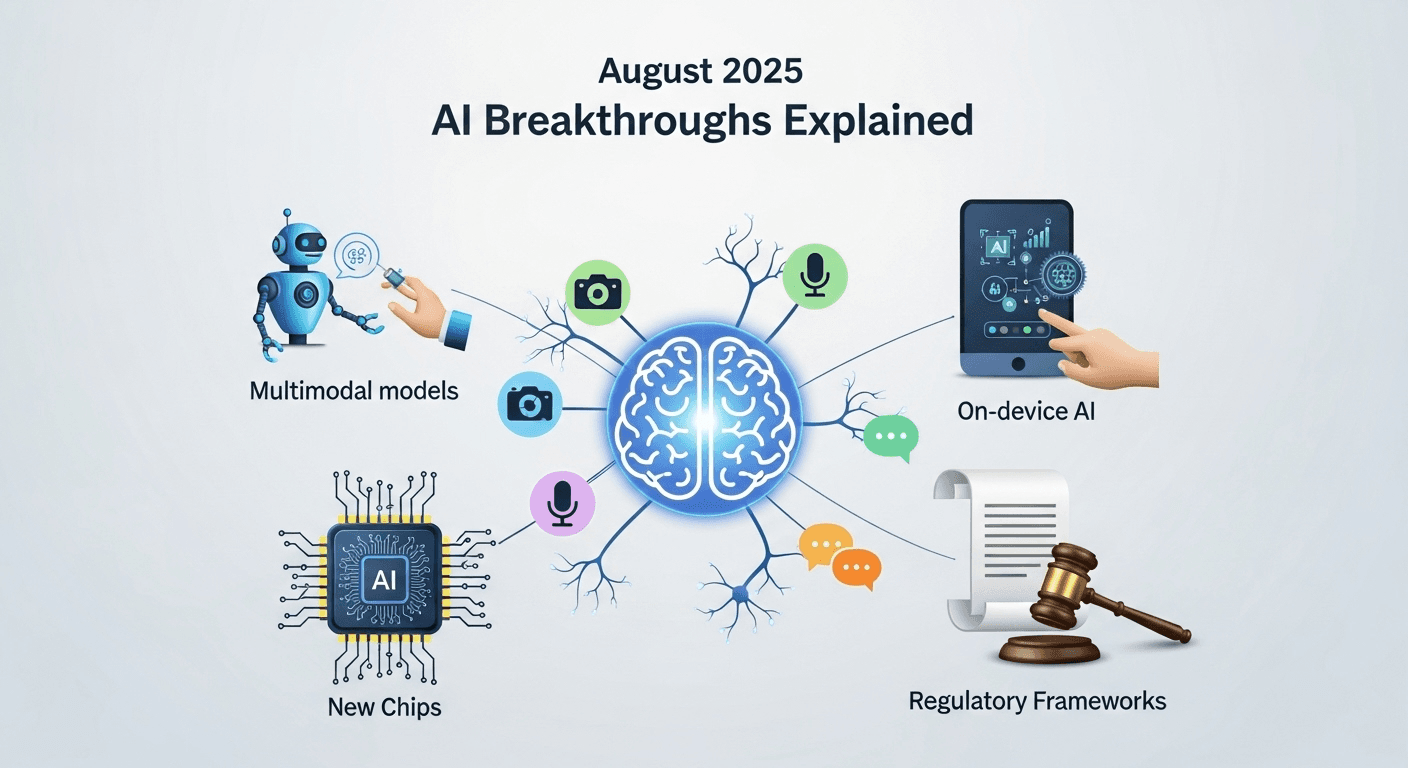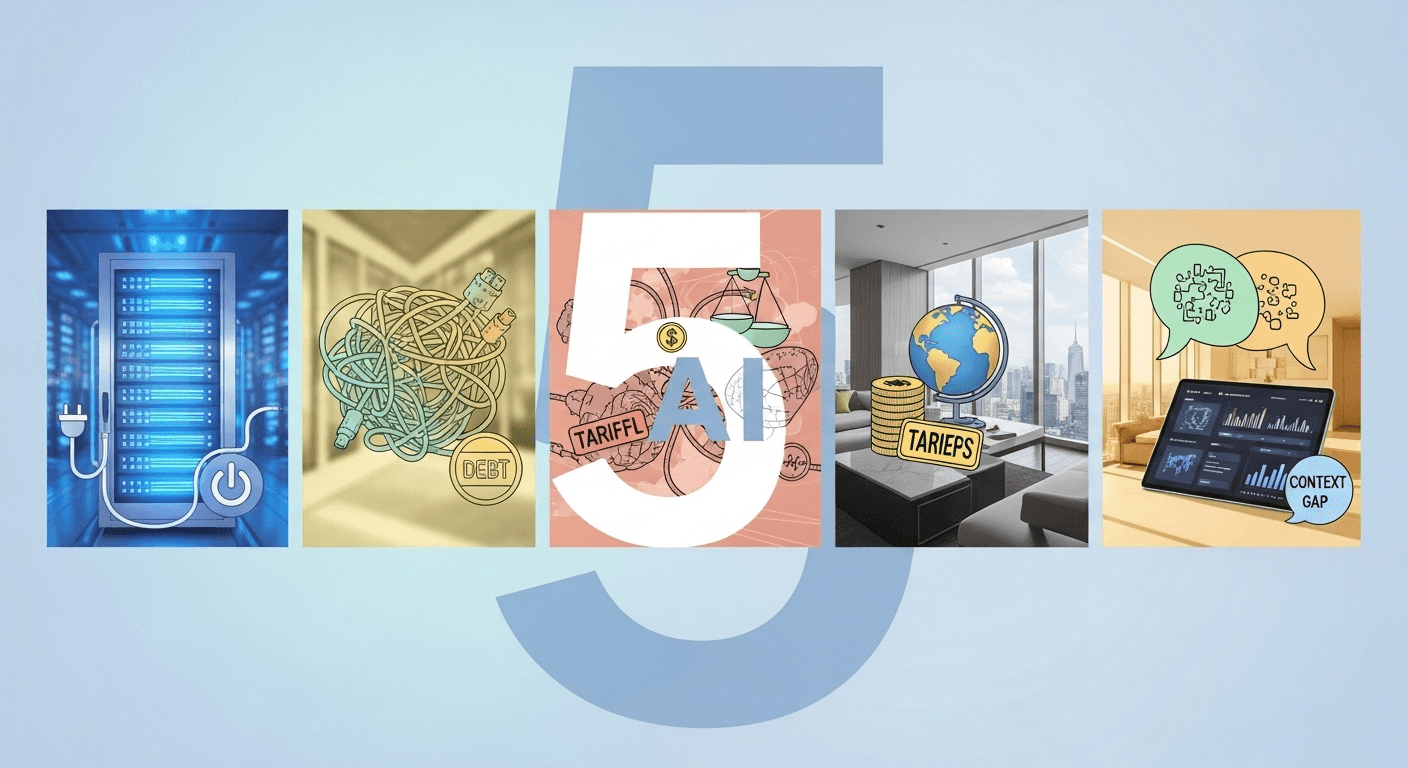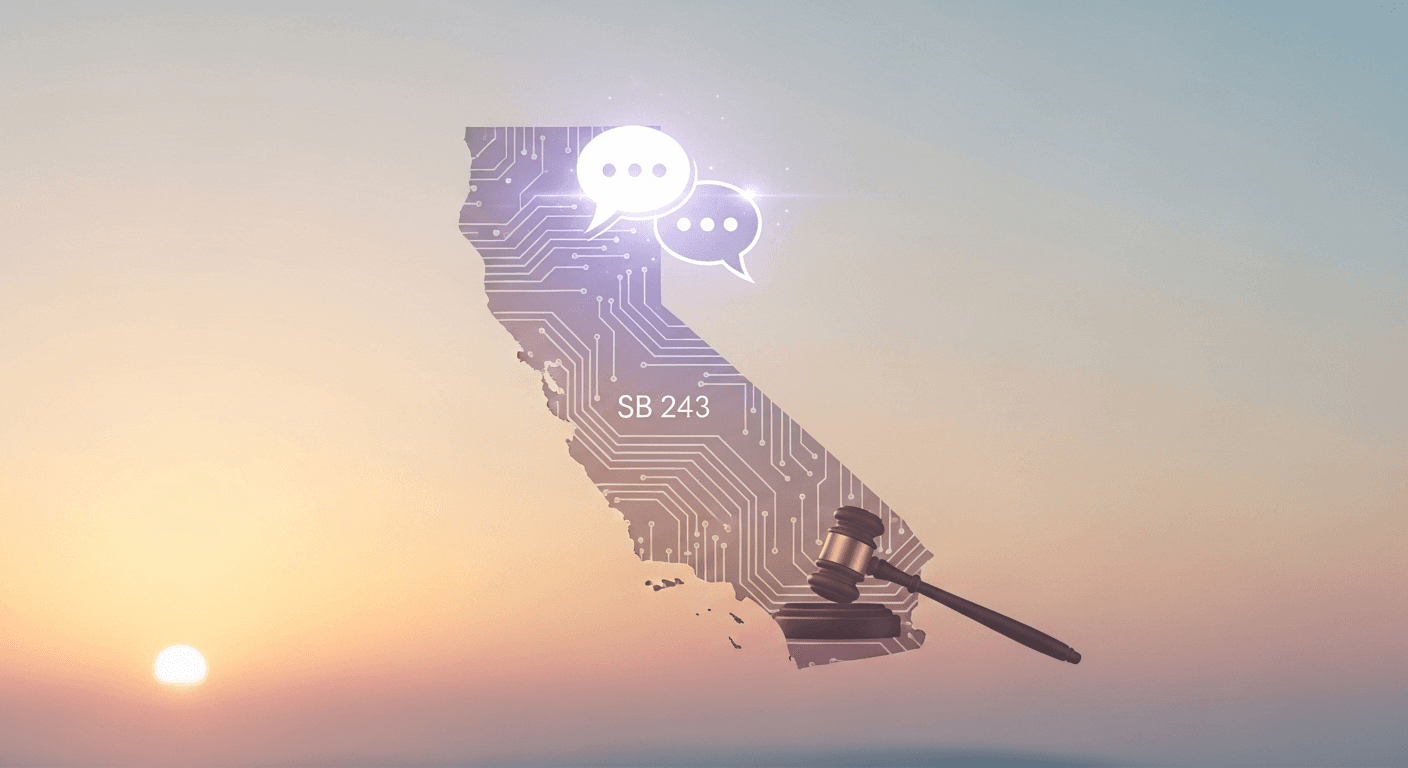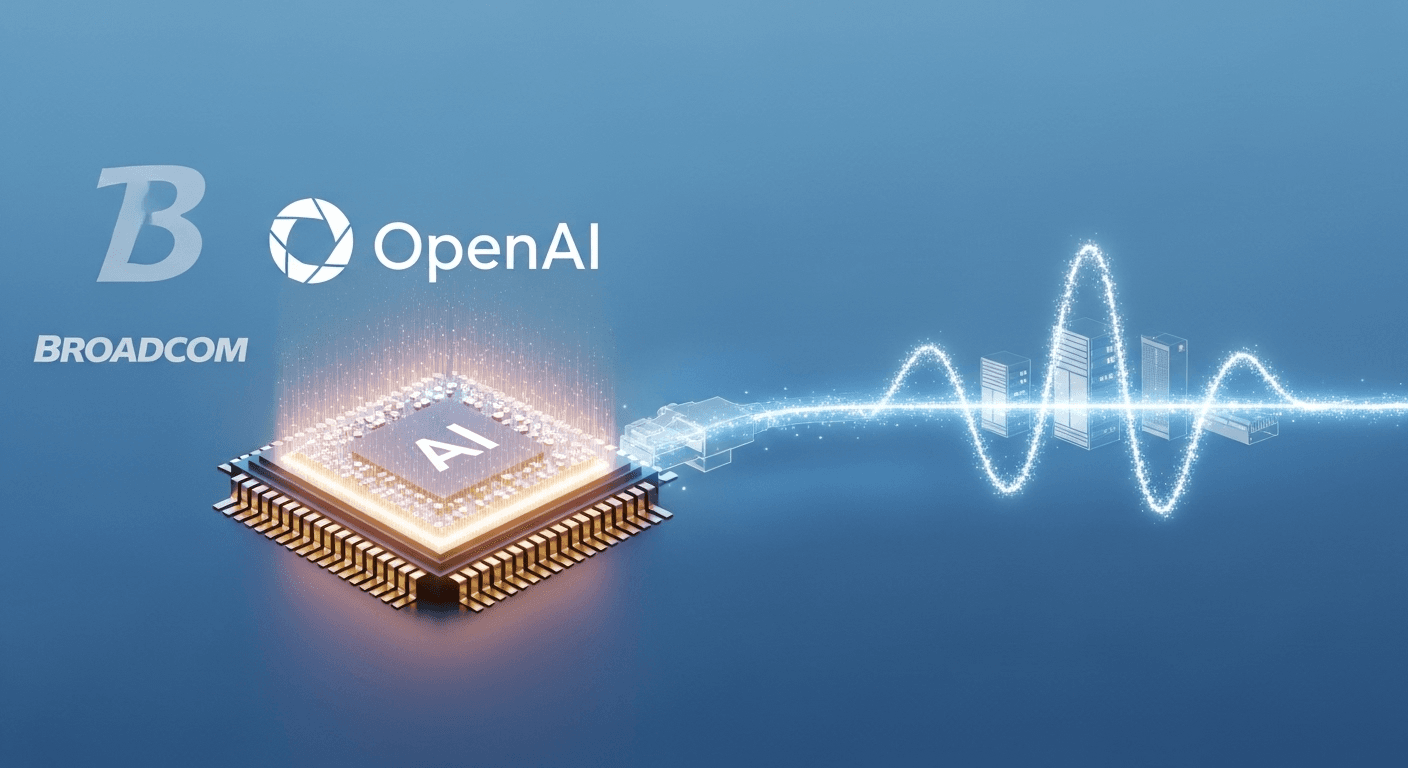August 2025 AI Breakthroughs Explained: Multimodal Models, Agents, Chips, and Real-World Impact

AI has transitioned from stunning demonstrations to essential infrastructure. As of August 2025, innovations like multimodal models, AI agents, on-device intelligence, and advanced chips are transforming how we work, create products, and manage technology. This overview outlines the key changes, their significance, and strategies for adaptation, all presented in clear language with reliable sources.
What’s Driving This Turning Point in August 2025?
Over the past year, several trends converged: AI models gained the ability to see, hear, and act; personal computers and smartphones integrated neural chips for local intelligence; data centers adopted next-generation accelerators; and frameworks for responsible AI became more defined. The result? A transformative leap in functionality. Rather than merely typing a prompt and waiting for a response, we now have systems that can observe screens, utilize tools and workflows, and operate safely within defined parameters.
Multimodal AI Becomes the Norm
Modern AI systems are no longer limited to processing just text. They can accept images, video, and audio as inputs and respond accordingly in various formats. This evolution is significant because it reflects how people naturally communicate and how tasks are accomplished in real-life scenarios.
- OpenAI launched GPT-4o, designed for real-time conversations across text, vision, and audio, featuring low latency and live tool access (OpenAI).
- Google’s Gemini 1.5 incorporates long context windows and native multimodal capabilities, enabling complex tasks such as reasoning over extensive videos and large codebases (Google).
- Anthropic’s Claude 3.5 Sonnet excels in reasoning with vision capabilities and tool utilization, enhancing reliability for enterprise applications (Anthropic).
- Meta introduced Llama 3, which offers high-quality open models for developers to fine-tune or deploy privately (Meta).
Why is this crucial? Multimodality streamlines processes. Instead of merely describing a chart, you can visually present it. Instead of transcribing a meeting, the model listens and generates actionable items. For product teams, this opens doors to new interfaces, enabling everything from voice-driven assistants to applications that monitor processes and suggest optimizations.
AI Agents: Transitioning from Chatbots to Effective Executors
AI agents are systems that strategize around objectives, make calls to tools, and coordinate actions to accomplish tasks. This year, the approach evolved: agents operate under defined permissions, grounded in user data, and are designed for transparency.
- Developers can connect models to tools and APIs via frameworks like Copilot Studio, tailored for enterprise workflows (Microsoft).
- Leading models now reliably utilize tools for tasks like retrieval, structured data extraction, code execution, and robotic process automation-style functions (Anthropic; Google).
Establishing best practices is becoming essential: define specific scopes and timeframes, maintain human oversight for irreversible actions, log every step, and validate outputs against known criteria. If it can’t be monitored and tested, it’s not ready for real-world application.
On-Device AI Achieves Widespread Adoption, Enhancing Privacy and Cost Efficiency
On-device AI is now more than just offline functionality. Running models locally reduces latency, secures sensitive information, and lowers cloud expenses. The consumer market has propelled this trend forward.
- Apple launched Apple Intelligence, integrating a personal AI system across iPhone, iPad, and Mac, featuring private cloud computation and local capabilities for writing, images, and smarter Siri functions (Apple).
- Microsoft introduced Copilot+ PCs equipped with dedicated NPUs to run local AI features and third-party applications more effectively (Microsoft).
- AI-centric chips for laptops, including Intel Lunar Lake and Qualcomm Snapdragon X Elite, were launched by hardware partners to boost on-device inference (Intel; Qualcomm).
Takeaway: Anticipate hybrid applications that divide tasks between the device and the cloud, maintaining sensitive information locally while offloading heavier processing to the cloud as needed.
Generative Video and Audio Become Viable Tools
Text-to-video and AI audio technologies have advanced from being mere curiosities to practical tools for creating storyboards, marketing material, educational content, and prototypes.
- OpenAI previewed Sora, a text-to-video model capable of generating photorealistic scenes and smooth motion throughout longer clips (OpenAI).
- Runway’s Gen-3 Alpha emphasizes artistic control, consistent subjects, and improved physics, facilitating creative workflows (Runway).
- Luma’s Dream Machine presents fast and accessible text-to-video options for creators and teams (Luma AI).
Risks and safeguards are developing as well. Content provenance standards like C2PA aim to attach tamper-evident metadata upon creation, while watermarking technologies like Google DeepMind’s SynthID assist in identifying AI-generated media at scale (C2PA; Google DeepMind).
Enterprise AI Stacks: RAG, Governance, and Observability
Businesses are increasingly viewing AI as a comprehensive system rather than just a feature. This leads to improved data management, retrieval-augmented generation, and thorough monitoring.
- Retrieval augmented generation (RAG) remains the backbone of providing accurate, contextual answers, relying on effective document chunking, metadata quality, and retrieval processes. See industry research for further insights on the trade-offs involved in RAG implementations (IBM Research).
- Vector databases and embeddings have become integral components in mainstream storage solutions like PostgreSQL through pgvector (PostgreSQL).
- Governance and observability are being integrated from the outset: prompt versioning, policy enforcement, test sets for drift and regression tracking, and incident response plans.
Practical guidance: commence with narrow, high-impact use cases such as support queries, contract analysis, or workflows assisted by agents. Evaluate success based on latency, accuracy, and time saved, not solely on model performance metrics.
The Hardware Evolution: Blackwell, TPUs, and the Cost of Intelligence
Advancements in AI heavily rely on computational power. The past year has ushered in significant enhancements in accelerators and infrastructure.
- NVIDIA introduced the Blackwell platform, featuring the B200 GPU and GB200 Grace Blackwell, engineered to boost both training and inference efficiency (NVIDIA).
- Google launched Cloud TPU v5p, optimized for large-scale training within Google Cloud (Google Cloud).
- AMD’s Instinct MI300 series expanded the accelerator landscape, contributing supply and architectural diversity (AMD).
Energy efficiency and sustainability remain top of mind. Global electricity consumption from data centers and networks is on the rise, with AI accounting for a significant share of that growth. Policymakers and providers are investigating strategies for efficiency, siting, and clean energy solutions to manage this demand responsibly (IEA).
Trust, Safety, and Regulation Become Concrete
Regulatory bodies and governments have translated ethical principles into enforceable guidelines and frameworks.
- The EU AI Act adopts a risk-based framework with obligations for developers and implementers, requiring transparency, rigorous testing, and incident reporting tailored to risk profiles (Official Journal of the EU).
- The United States has put forth an Executive Order focused on creating safe, secure, and trustworthy AI systems, directing efforts toward standard development, safety testing, and comprehensive reporting for high-capacity models (The White House).
- NIST has released the AI Risk Management Framework and established the AI Safety Institute along with its consortium to accelerate testing, benchmarks, and best practices (NIST AI RMF; NIST AISI).
- The UK has founded an AI Safety Institute with a focus on evaluating advanced models, conducting red teaming exercises, and measuring capabilities (UK AISI).
Copyright and provenance issues have gained significant attention, highlighted by high-profile legal battles that reveal the tension between training data and rights holders. The industry is leaning towards licensed datasets and content credentials for creators (New York Times; Adobe Firefly).
The Role of AI in Scientific and Health Advances: Real Potential, Cautious Implementation
Breakthroughs in science and medicine showcase AI’s promise, underscoring the necessity for thorough validation.
- DeepMind’s AlphaFold 3 has extended the capabilities of protein structure prediction, enabling exploration of broader biomolecules and interactions, thereby paving the way for advancements in drug discovery and biological research (DeepMind).
- Google researchers unveiled AMIE, a clinical AI assistant study aimed at assessing how large language models can enhance medical reasoning and patient communication under clinical supervision (Google Research).
- Global health authorities continue to advocate for careful evaluation, bias detection, and documentation before deploying AI tools in clinical settings (WHO Guidance).
The key takeaway? In high-stakes environments, AI should enhance professional capabilities rather than replace them.
Work, Skills, and the Evolving Human-Computer Partnership
AI is reshaping workflows in office applications, coding environments, and creative tools. The most significant productivity improvements arise when processes are redesigned to leverage AI’s strengths.
- Productivity tools embedded within Office and Workspace applications are evolving from simple autocompletion to comprehensive task assistants that facilitate searching, summarizing, and drafting documents across multiple platforms (Microsoft; Google).
- Teams that align prompts, data retrieval, and tool usage towards specific outcomes experience fewer inaccuracies and can measure their impact more effectively.
- Workforces are increasingly focusing on AI literacy, which includes reviewing outputs, crafting effective prompts, and determining when to seek human intervention.
Economists predict uneven effects across various roles, with collaboration becoming more prevalent than outright job replacement in the near future. Training and job design will dictate who benefits the most from these advancements (IMF).
How to Prepare Your Roadmap
Whether you’re a developer, investor, or policymaker, a strategic approach will help you harness value while also managing risks associated with AI.
- Identify real problems. Focus on workflows with repetitive decision-making and information retrieval to pilot small use cases and expand based on demonstrated savings.
- Select the appropriate model for each task. Opt for smaller, faster models on devices for straightforward tasks and employ larger models in the cloud for more complex reasoning.
- Ensure comprehensive tracking. Log inputs and outputs, append relevant metadata, and monitor for any anomalies, inaccuracies, and safety issues.
- Anchor models in your own data using RAG. Clean and manage document sources, ensure version control, and evaluate the quality of information retrieval as a key metric.
- Develop guardrails and governance frameworks. Draft policies, conduct red-teaming for critical functions, and execute pre-deployment assessments. Maintain human oversight for high-stakes decisions.
- Consider costs and energy consumption. Utilize batching, caching, and model distillation techniques. Prioritize on-device processing where feasible and collaborate with partners who demonstrate credible sustainability efforts.
- Invest in workforce development. Equip teams to critique outputs, develop testable prompts, and escalate decision-making processes. Treat change management with equal importance to model performance.
Conclusion: AI is Becoming Truly Useful
Looking back at August 2025, it’s clear there’s a significant transformation taking place. AI is moving away from being just a source of impressive showcases to becoming an integral part of systems that provide genuine assistance. Multimodal models grasp more nuanced contexts, AI agents bring intentions to life, localized chips make intelligence more accessible, and regulations clarify responsibilities. The leaders in this field will be those who merge capabilities with thoughtful design, governance, and a clear strategy for solving real problems.
FAQs
What is multimodal AI, and why is it significant?
Multimodal AI processes various input types, including text, images, audio, and video, aligning better with human communication and workflow. For instance, a support agent could show a screenshot, and the AI would comprehend and suggest next steps.
Are AI agents safe for production environments?
They can be safe if designed with defined scopes, permissions, and observation mechanisms. It’s crucial to have human oversight for risky operations, enforce strict tool permissions, and thoroughly test against real-world scenarios before deployment.
What impact will the EU AI Act have on companies?
The EU AI Act introduces obligations based on risk levels. High-risk systems will face stringent requirements, including testing, documentation, and incident reporting, while general-purpose and lower-risk applications will have comparatively lighter requirements but still demand transparency and diligence.
Should we prioritize on-device AI?
A hybrid approach is recommended. Execute smaller or sensitive tasks locally to improve responsiveness and secure data while accessing the cloud for extensive computations or long-context operations. Many applications successfully blend both approaches based on user preferences and cost considerations.
How can we detect media generated by AI?
Implement layered defenses: utilize content credentials like C2PA to document assets at creation, watermarking such as SynthID when possible, and employ detection algorithms within publishing workflows. Train staff to recognize common characteristics and verify sources.
Sources
- OpenAI – Introducing GPT-4o
- Google – Gemini 1.5
- Anthropic – Claude 3.5 Sonnet
- Meta – Llama 3
- OpenAI – Sora
- Runway – Gen-3 Alpha
- Luma AI – Dream Machine
- C2PA – Content Provenance
- Google DeepMind – SynthID
- EU AI Act – Official Journal
- US Executive Order on AI
- NIST AI Risk Management Framework
- NIST AI Safety Institute
- UK AI Safety Institute
- NVIDIA – Blackwell Platform
- Google Cloud – TPU v5p
- AMD – Instinct MI300
- IEA – Data Centres and Data Transmission Networks
- Apple – Apple Intelligence
- Microsoft – Copilot+ PCs
- Intel – Lunar Lake
- Qualcomm – Snapdragon X Elite
- New York Times – OpenAI Lawsuit
- Adobe – Firefly Data and Licensing
- DeepMind – AlphaFold 3
- Google Research – AMIE
- WHO – Generative AI in Health Guidance
- IBM Research – RAG
- PostgreSQL – pgvector
- IMF – Generative AI and Jobs
Thank You for Reading this Blog and See You Soon! 🙏 👋
Let's connect 🚀
Latest Blogs
Read My Latest Blogs about AI

5 AI Stories Shaping Business Today: Power, Data Debt, Tariffs, Penthouses, and the Context Gap
A clear roundup of 5 AI trends shaping business now: power-hungry data centers, data debt, AI for tariffs, luxury sales with AI, and the context gap — with takeaways.
Read more


